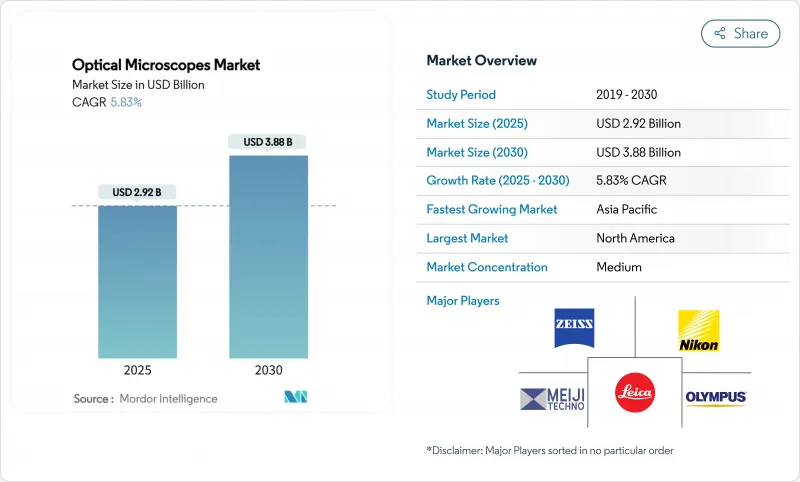
|
市場調査レポート
商品コード
1852139
光学顕微鏡:市場シェア分析、産業動向、統計、成長予測(2025年~2030年)Optical Microscopes - Market Share Analysis, Industry Trends & Statistics, Growth Forecasts (2025 - 2030) |
||||||
カスタマイズ可能
適宜更新あり
|
|||||||
| 光学顕微鏡:市場シェア分析、産業動向、統計、成長予測(2025年~2030年) |
|
出版日: 2025年08月01日
発行: Mordor Intelligence
ページ情報: 英文 110 Pages
納期: 2~3営業日
|
概要
光学顕微鏡市場規模は2025年に29億2,000万米ドル、2030年には38億8,000万米ドルに達すると推定・予測され、予測期間(2025-2030年)のCAGRは5.83%です。

機械学習アルゴリズムは現在、画像の取得と解釈を自動化し、分析時間を数時間から数分に短縮し、ラボが大量のサンプルに対応できるようにしています。量子センサーの統合により、空間分解能が10ナノメートルまで向上し、分子生物学やナノ材料研究に新たな調査窓口が開かれつつあります。特に米国国立衛生研究所の共有機器助成金による資金流入は、学術施設や臨床施設の強固なアップグレードサイクルを支えています。一方、50米ドルを下回る価格の完全3Dプリント光学アセンブリのような民主化された製造は、資源が限られた環境での導入障壁を下げ始めています。
世界の光学顕微鏡市場の動向と洞察
生命科学研究開発への資金援助の増加
NIHの1億3,000万米ドルをかけた低温電子顕微鏡の拡張や、プリンストン大学の基金が支援する光学コアのアップグレードなど、連邦政府や慈善団体による次世代イメージング施設の資金援助が行われています。助成金の仕組みは、共同利用モデルを支持し、利用率を高め、汎用性の高いモジュール式プラットフォームへの調達に舵を切っています。資本の利用可能性の向上は、特に蛍光装置や超解像装置に有利であり、そのプレミアム価格は高度な生物医学的使用事例に合致しています。そのため、光学顕微鏡市場は、学術コンソーシアムや地域研究ネットワークにおいて、複数年にわたるオーダーの可視性を確保しています。
デジタル化とAIによる画像分析
ディープラーニング・パイプラインは、腫瘍のグレーディング作業において、専門病理医と同等かそれ以上の能力を発揮するようになり、顕微鏡がほぼリアルタイムで実用的な洞察を提供できるようになりました。ATOMICのようなフレームワークは、ゼロショットの材料特性評価を実証し、事前に訓練されたモデルのボトルネックを取り除き、産業応用の可能性を広げています。カメラセンサーに直接組み込まれたエッジコンピューティングはレイテンシーを削減し、AIによって誘導される適応型照明は光毒性被ばくを2桁パーセント削減します。その結果、光学顕微鏡市場では、光学機器単体よりも、統合されたハードウェア・ソフトウェア・バンドルの需要が高まっています。
分解能のギャップと電子顕微鏡の比較
光学系は回折の影響を受け、可視光の解像度が200ナノメートル付近に制限されるのに対し、電子顕微鏡は日常的にサブオングストロームの領域に突入しています。MINFLUXとその関連モダリティは、生物学的イメージングを1-3ナノメートル領域に縮小しているが、材料科学は依然として、格子レベルの知見を得るために電子プラットフォームへと引き寄せられています。標準的なTEMを用いた電子プチコグラフィーの進歩は、コストのかかる収差補正なしで0.44オングストロームの解像度を実現することで、この比較をさらに強めています。その結果、一部の資本予算は、純粋な光学アップグレードよりもマルチテクニックラボに傾き、高精度冶金や半導体ファブにおける光学顕微鏡市場成長の可能性を削いでいます。
セグメント分析
デジタルサブカテゴリは、2024年の光学顕微鏡市場の36.92%を占め、瞬時のレンダリングと注釈のために光学系とグラフィック処理ユニットを統合するカメラ中心のアーキテクチャへの決定的なシフトを反映しています。研究者や臨床医は、統合された電動ステージ、スペクトルのアンミキシング、エンドツーエンドの解析時間を短縮するAI対応のファイル形式を高く評価しています。一方、蛍光および超解像システムは、2030年までのCAGRが7.56%と予測され、成長を牽引しています。これは、λ/33軸分解能の決定論的ナノスコピーのような画期的な技術が、細胞内機械の体積イメージングを可能にしたことによる。実体顕微鏡は、電子機器の検査や生命科学の解剖に役立っています。磁気共鳴を10ナノメートルの光信号に変換できる量子センサーが登場し、従来の製品ラインが曖昧になりつつあります。
オープンソースのエコシステムは、反復サイクルを加速させる。大学は現在、細胞内を鮮明にする3Dプリント可能なリグを50米ドル以下でリリースしており、媒介感染症の現場監視における採用の起爆剤となっています。市場のリーダーたちは、AIガイドのオートフォーカスやクラウドテレメトリーを組み込むことで対応し、ソフトウェアによる差別化を強化しています。長期観察をサポートするライブセルチャンバーにより、倒立型フォーマットがバイオプロセス施設内で支持を集める。その結果、デジタルラインと蛍光ラインの光学顕微鏡市場規模は、エントリーレベルのセグメントが価格圧縮と格闘しているとしても、今後半世紀にわたって増収の大部分を占めると予測されます。
地域分析
北米は2024年の収益貢献率34.13%で光学顕微鏡市場をリードしており、NIHが資金提供するクライオ電子顕微鏡ハブと確立された臨床病理ワークフローに支えられています。しかし、慢性的な臨床検査技師不足により、2024年には46%の空室が報告され、スループットが制限されるため、病院は自動化と統合AIプラットフォームを優先するようになります。遠隔診察が標準化され、市場参入企業がスキャナー、分析、クラウド・ストレージをサブスクリプション・モデルにパッケージ化し、予測可能な支出を確保するようになると、デジタル病理学の普及率が上昇します。
アジア太平洋地域は、2030年までCAGR 11.09%で拡大し、最速の移動体です。中国の地方政府は、マルチフォトンや量子センサーユニットを含む第三次病院のアップグレードに複数年の予算を割り当てており、インドの診断部門は分散型イメージングのための肥沃な土壌を作り出しています。サプライヤーは現地化を加速ZEISSは蘇州に1万3,000平方メートルの研究開発・製造拠点を開設し、現地のプロトコルに合わせた光学系とソフトウェアを提供します。しかし、一部の市場では規制の不確実性と償還の遅れが収益認識の遅れをもたらし、ベンダーはパートナーシップ主導の市場参入モデルを採用するよう促しています。
欧州は、Horizon Europeの研究助成金と、国境を越えた販売を簡素化するCEマークの一貫した枠組みに後押しされ、バランスの取れた成長を維持しています。中東・アフリカと南米は、政府がヘルスケアの自給自足を重視し、G7機関との学術提携が技術移転を促進しているため、全体として光学顕微鏡市場で小幅ながら成長を加速しています。
その他の特典:
- エクセル形式の市場予測(ME)シート
- 3ヶ月間のアナリストサポート
よくあるご質問
目次
第1章 イントロダクション
- 調査の前提条件と市場の定義
- 調査範囲
第2章 調査手法
第3章 エグゼクティブサマリー
第4章 市場情勢
- 市場概要
- 市場促進要因
- ライフサイエンス研究開発資金の増加
- デジタル化とAIによる画像分析
- ナノテクノロジーに牽引される顕微鏡需要の急増
- 臨床ポイントオブケア顕微鏡の成長
- オープンソースハードウェアと3Dプリンティング光学部品
- ラボオンチップ/マイクロ流体インテグレーション
- 市場抑制要因
- 分解能の差と電子顕微鏡の比較
- 低価格ブランドによる価格侵食
- 先端顕微鏡技術者の不足
- 低コスト代替品の入手可能性
- テクノロジーの展望
- ポーターのファイブフォース分析
- 新規参入業者の脅威
- 買い手の交渉力
- 供給企業の交渉力
- 代替品の脅威
- 競争企業間の敵対関係
第5章 市場規模と成長予測(単位:米ドル)
- 製品別
- 複合顕微鏡
- ステレオ顕微鏡
- デジタルマイクロスコープ
- 倒立顕微鏡
- 蛍光・超解像顕微鏡
- その他
- エンドユーザー別
- 病院&クリニック
- 学術・研究機関
- 診断ラボ
- 製薬・バイオテクノロジー企業
- 地域別
- 北米
- 米国
- カナダ
- メキシコ
- 欧州
- ドイツ
- 英国
- フランス
- イタリア
- スペイン
- その他欧州地域
- アジア太平洋地域
- 中国
- 日本
- インド
- オーストラリア
- 韓国
- その他アジア太平洋地域
- 中東・アフリカ
- GCC
- 南アフリカ
- その他中東・アフリカ
- 南米
- ブラジル
- アルゼンチン
- その他南米
- 北米
第6章 競合情勢
- 市場集中度
- 市場シェア分析
- 企業プロファイル
- Carl Zeiss AG
- Nikon Instruments Inc.
- Leica Microsystems(Danaher)
- Olympus Corporation
- Bruker Corporation
- Hitachi High-Tech Corp.
- Agilent Technologies
- Keyence Corp.
- Thermo Fisher Scientific
- Meiji Techno
- Labomed Inc.
- AmScope
- Celestron
- Accu-Scope Inc.
- Motic Microscope
- Andor Technology(Oxford Instr.)
- Jenoptik AG
- Prior Scientific Instruments
- Dino-Lite(AnMo Electronics)
- OPTO-Tech

